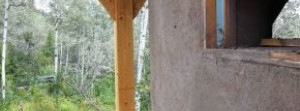
Wabi-sabi: The beauty in the bulge
Straw bale houses aren’t for folks who like straight lines and clean edges. Someone who’s, say, a perfectionist probably shouldn’t build a straw bale house. Someone who likes crisp corners and symmetry might want to stick to drywall and stud frames.
But if you, like us, love a little wabi-sabi, straw bale building offers a type of forgiveness only found in nature.
Wabi-sabi is a Japanese aesthetic that glorifies imperfection. It finds beauty in the simple, the uneven, the unfinished. According to Wikipedia, “Characteristics of the wabi-sabi aesthetic include asymmetry, asperity (roughness or irregularity), simplicity, economy, austerity, modesty, intimacy and appreciation of the ingenuous integrity of natural objects and processes.”
It also sounds a little like “wonky.” I like that.
The concept is one that’s been raised a lot in the process of our straw bale building. We’ve had, on many occasions, to release our expectations of perfection as some things fall into place a little skewed. When straw bales are stacked off centre or a little too long, the result is bulges in the finished wall, which, once plastered, are near impossible to fix.
So, instead, you embrace. You laugh at the character that misplaced bale offers your home. You shake your head and say, “wabi-sabi.”
Wabi-sabi is also finding its way into our décor. We bought an old cast iron bathtub and, after its inside enamel was restored to a shiny white, I began meticulously rusting the outside with a spray bottle. When it’s ready, I’ll give it a light sand and rub it down with linseed oil, to maintain its rust-coloured exterior.
image3For our kitchen backsplash, we used bricks salvaged from a friend’s old chimney, mortar residue giving them a dusty appearance. We’ve got antique doors that, under their layers of paint, reveal beautiful fir and a lot of wabi-sabi: old nail holes, paint remnants and scars left from the cracks fixed by Nick.
A friend who recently came for dinner drily suggested we might want to introduce some carpenter ants to our timbers.
The beauty of wabi-sabi is that it’s so freeing. Instead of pursuing perfection, embracing character; instead of buying new, loving the old; instead of needing something more, loving what you have, just the way it is (or perhaps with a light sand and some timber oil). All natural materials—whether it’s slate, wood or straw—offer the same forgiveness in being neither perfect nor square. As a result, you can’t go too far wrong. image9
Let’s face it: we all have a little wabi-sabi. Like old doors and rusty bathtubs, we all have a story to tell. And we hope that someone will see our flaws as character, the deepening lines around our eyes as patina and our bulges as beautiful. If our old door and bathtub could talk, I think they’d thank us for rescuing them from the back paddock or a forgotten storage room and loving them for what they are.
That’s not to say our entire house looks shabby and misshapen. I love the juxtaposition of our mortar-stained backsplash above our new stainless steel stove. Our rusted bathtub next to our patina-free toilet. Our gently undulating walls against Nick’s tall and beautiful timbers.
The secret is adding just the right amount of wabi-sabi. I mean, we didn’t put all this time and effort into our house to make it look like new.
http://strawbaletales.wordpress.com/





